Method and apparatus for probe sensor assembly
a technology of probe sensor and assembly method, which is applied in the field of bracket system, can solve the problems of less accurate detection of the elements of the reluctor as it spins in relation to the magnetic sensor, more noise-induced failure of the sensor operation, and inability to detect the elements of the reluctor in the direction of the magnetic sensor, etc., and achieve the effect of eliminating any potential air gap
- Summary
- Abstract
- Description
- Claims
- Application Information
AI Technical Summary
Benefits of technology
Problems solved by technology
Method used
Image
Examples
Embodiment Construction
Referring now to the Drawings, FIGS. 1 and 2 generally depict an exemplary embodiment of a sensor probe bracket system 10 according to the present disclosure in an exemplar environment of operation, wherein the bracket system serves to locate a magnetic sensor 12 with respect to a reluctor 14. In this regard, the magnetic sensor 12 has a sensor body 16 which includes a sensor tip 18. The sensor tip 18 extends into a sensor bore 20 of an engine block 22, for example, via sensor housing 24 that is spaced from the reluctor 14 a predetermined distance equal to an optimum air gap G which provides optimal sensing performance by the magnetic sensor of magnetic field variations as the reluctor spins.
A sensor probe component bracket 26 (hereafter, simply “bracket”) of the sensor probe bracket system 10 is composed of a first bracket component 28 and a second bracket component 30 which lie substantially parallel with each other and are oriented parallel to a horizontal axis H and normal to th...
PUM
 Login to View More
Login to View More Abstract
Description
Claims
Application Information
 Login to View More
Login to View More - R&D
- Intellectual Property
- Life Sciences
- Materials
- Tech Scout
- Unparalleled Data Quality
- Higher Quality Content
- 60% Fewer Hallucinations
Browse by: Latest US Patents, China's latest patents, Technical Efficacy Thesaurus, Application Domain, Technology Topic, Popular Technical Reports.
© 2025 PatSnap. All rights reserved.Legal|Privacy policy|Modern Slavery Act Transparency Statement|Sitemap|About US| Contact US: help@patsnap.com



